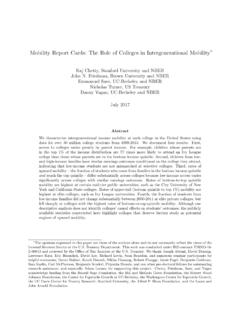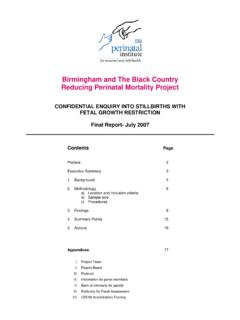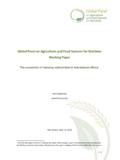Transcription of Race and Economic Opportunity in the United States
1 THE EQUALITY OF Opportunity PROJECT. Race and Economic Opportunity in the United States Executive Summary Raj Chetty, Nathaniel Hendren, Maggie Jones, and Sonya R. Porter Racial disparities in income and other outcomes are among the most visible and persistent features of American society. The sources of these disparities have been studied and debated for decades, with explanations ranging from residential segregation and discrimination to differences in family structure and genetics. Most previous work on racial disparities has studied inequality within a single generation of people. In a new study, we analyze how racial gaps change across Using de-identified data covering 20 million children and their parents, we show how race currently shapes Opportunity in the and how we can reduce racial disparities going Finding #1: Hispanic Americans are moving up in the income distribution across generations, while black Americans and American Indians are not.
2 We study five racial and ethnic groups: people of Hispanic ethnicity and non- Hispanic whites, blacks, Asians, and American Indians. By analyzing rates of upward and downward mobility across generations for these groups, we quantify how their incomes change and predict their future earnings trajectories. Children's Incomes vs. Parents' Incomes, by Race and Ethnicity 1 This summary and all figures that appear below are based on the paper Race and Economic Opportunity in the United States : An Intergenerational Perspective. The views expressed in this executive summary are not necessarily those of the Census Bureau. The statistical summaries reported in these slides have been cleared by the Census Bureau's Disclosure Review Board release authorization number CBDRB-FY18-195. 2. The dataset used for the analysis includes children born in the or those whose parents came to the as authorized immigrants while they were children.
3 Race and Economic Opportunity in the United States Executive Summary Hispanic Americans have rates of upward income mobility across generations that are slightly below those of whites. Hispanics are therefore on a path to moving up substantially in the income distribution across generations, potentially closing much of the present gap between their incomes' and those of white Americans. Asian immigrants have much higher levels of upward mobility than all other groups, but Asian children whose parents were born in the have levels of intergenerational mobility similar to white children. This makes it more difficult to predict the trajectory of Asian Americans' incomes, but Asians appear likely to remain at income levels comparable to or above white Americans in the long run. In contrast, black and American Indian children have substantially lower rates of upward mobility than the other racial groups.
4 For example, black children born to parents in the bottom household income quintile have a chance of rising to the top quintile of household income, compared with for whites. Growing up in a high-income family provides black and American Indian no insulation from these disparities. American children have much higher Indian and black children have much higher rates of downward mobility rates of downward mobility than other groups. than other groups. black black children born to parents in the top children born to parents in the income quintile are almost as likely to fall to the bottom quintile as they are to remain in top income quintile are the top quintile. By contrast, white children almost as likely to fall to the born in the top quintile are nearly five times as bottom quintile as they are to likely to stay there as they are to fall to the remain in the top quintile.
5 Bottom. Because of these differences in Economic mobility, blacks and American Indians are stuck in place across generations. Their positions in the income distribution are unlikely to change without efforts to increase their rates of upward mobility. Changes in Income Across Generations, by Racial Group The Equality of Opportunity Project 2. Race and Economic Opportunity in the United States Executive Summary Finding #2: The black -white income gap is entirely driven by differences in men's, not women's, outcomes. Among those who grow up in families with comparable incomes, black men grow up to earn substantially less than the white men. In contrast, black women earn slightly more than white women conditional on parent income. Moreover, there is little or no gap in wage rates or hours of work between black and white women. We find analogous gender differences in other outcomes: black -white gaps in high-school completion rates, college attendance rates, and incarceration are all substantially larger for men than for women.
6 black women have higher college attendance rates than white men, conditional on parental income. For men, the gap in incarceration is particularly stark: 21% of black men born to the lowest- income families are incarcerated on a given day, far higher than for any other subgroup. Children's Incomes vs. Parents' Incomes, for black and White Men and Women Finding #3: Differences in family characteristics parental marriage rates, education, wealth and differences in ability explain very little of the black -white gap. black children are much more likely to grow up in single parent households with less wealth and parents with lower levels of education all factors that have received attention as potential explanations for black -white disparities. But, when we compare the outcomes of black and white men who grow up in two- parent families with similar levels of income, wealth, and education, we continue to find that the black men still have substantially lower incomes in adulthood.
7 Hence, differences in these family characteristics play a limited role in explaining the gap. Perhaps most controversially, some have proposed that racial disparities might be due to differences in innate ability. This hypothesis does not explain why there are black -white intergenerational gaps for men but not women. Moreover, black -white gaps in test scores which have been the basis for most prior arguments for ability differences are substantial for both men and women. The The Equality of Opportunity Project 3. Race and Economic Opportunity in the United States Executive Summary fact that black women have outcomes comparable to white women conditional on parental income despite having much lower test scores suggests that standardized tests do not provide accurate measures of differences in ability (insofar as it is relevant for earnings) by race, perhaps because of stereotype anxiety or racial biases in tests.
8 Finding #4: In 99% of neighborhoods in the United States , black boys earn less in adulthood than white boys who grow up in families with comparable income. One of the most prominent theories for why black and white children have different outcomes is that black children grow up in different neighborhoods than whites. But, we find large gaps even between black and white men who grow up in families with comparable income in the same Census tract (small geographic areas that contain about 4,250 people on average). Indeed, the disparities persist even among children who grow up on the same block. These results reveal that differences in neighborhood-level resources, such as the quality of schools, cannot explain the intergenerational gaps between black and white boys by themselves. black -white disparities exist in virtually all regions and neighborhoods. Some of the best metro areas for Economic mobility for low-income black boys are comparable to the worst metro areas for low-income white boys, as shown in the maps below.
9 And black boys have lower rates of upward mobility than white boys in 99 percent of Census tracts in the country. Average Incomes for black and White Men who Grow up in Low-Income (25th Percentile) Families Finding #5: Both black and white boys have better outcomes in low-poverty areas, but black -white gaps are bigger in such neighborhoods. Despite the prevalence of black -white gaps, there is substantial variation in rates of upward mobility for both black and white boys across areas, as illustrated in The Equality of Opportunity Project 4. Race and Economic Opportunity in the United States Executive Summary the maps above. Areas that have higher rates of upward mobility for whites tend to have higher rates of upward mobility for blacks as well. For both blacks and whites, upward mobility is highest for children who grow up in the Great Plains and the coasts and lowest in the cities in the industrial Midwest.
10 One notable exception to this pattern is the Southeast, where whites have especially low rates of upward mobility (relative to other whites nationwide) but blacks do not. Both black and white boys have better outcomes in neighborhoods commonly perceived to be good" areas: Census tracts with low poverty rates, high test scores, and a large fraction of college graduates. However, black -white gaps are larger on average for boys who grow up in such tracts, because whites benefit more from living in such areas than blacks do. Finding #6: Within low-poverty areas, black -white gaps are smallest in places with low levels of racial bias among whites and high rates of father presence among blacks. In low-poverty neighborhoods, two types of factors are most strongly associated with better outcomes for black men and smaller black -white gaps: low levels of racial bias among whites and high rates of father presence among blacks.







